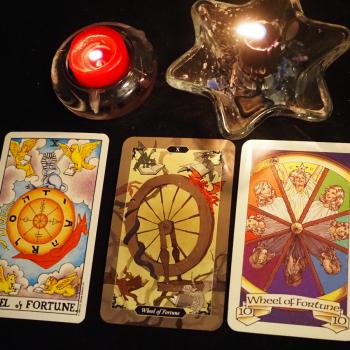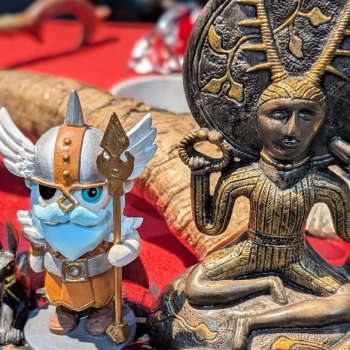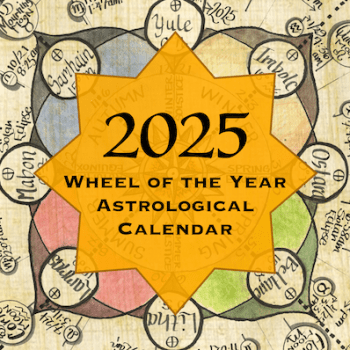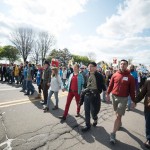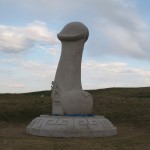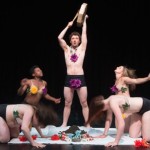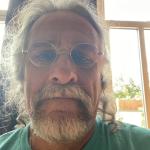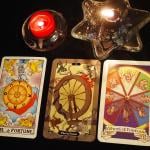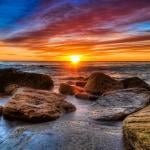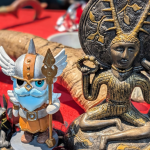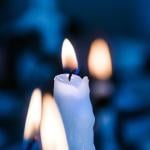Recently Teo Bishop wrote a wonderful post about his experience of doing ritual in nature. (Sometimes I think I should rename this blog “What I think about awesome things Teo Bishop has said”.) Anyway, in his post, Teo writes that when he performs a certain ritual indoors in the city, he lifts his hands toward the ceiling and imagines that he is feeling the warmth of the sun. He imagines that his feet have become roots, extending into the earth, far down into the underground waters. However, recently, he performed the same ritual outside, standing next to a reservoir under the morning sun. He writes:
“So I lifted my hands up to the sky, and when I felt the warmth of the sun — the actual warmth, and not the imagined warmth — I was taken aback. I opened my eyes and I saw the water. The actual water. The Two Powers meditation felt a little silly to do at that point, ’cause I was in the sun and I could almost feel the water on my skin. I didn’t need to imagine anything.”
Rather than imagining nature, Teo suggests that his practice should consist of opening his senses to what is actually around him. He goes on to state that Druid (and I would add “Pagan”) practice must be an experience of the living earth, not simply the metaphoric earth. By turning natural phenomena into metaphors for human experiences, Teo writes, we can be misled into believing that the “outer” natural world exists only as a reflection of the “inner” human world. Teo concludes, “The tree doesn’t always need to represent something. It can simply be alive, and beautiful.”
The problem of representing nature is one that has haunted Neo paganismfrom the start, and I think it highlights a line between what I recognize as Paganism and what I call esotericism. This is something that Peregrin Wildoak has written about on his blog, Magic of the Ordinary, here and here and here. I urge you to peruse Peregrin’s blog. He is an esotericist, but one who engages with nature in a way that puts many Neopagans to shame.
Examples of Neopagan confusion about nature include early Neopagans in the southern hemisphere following a Wheel of the Year that corresponds to the Northern Hemisphere, or Pagans on the West Coast of the United States following a Wheel of the Year that corresponds to the climate of the British Isles. This is what Joanne refers to when she asks: “to what extent does the Wheel turn the seasons instead of the seasons turning the Wheel?” (“Wicca, Esotericism an Living Nature: Assessing Wicca as a Nature Religion”, The Pomegranate, vol. 14 (2000)). In other words, do the celebrations of the eight sabbats actually bring Neopagans any closer to nature?
Working out the Wheel of the Year has been a long process for me. Due to the seasonal lag here in the Midwest, we do not experience really feel the changing of the seasons with the equinoxes and solstices, but rather with the cross-quarter days, which follow about six to seven weeks after the preceding quarter days. February is not the beginning of spring and May is not the beginning of summer. Our “mid-Winter” is in February, not December, and our “mid-summer” is in August, not June. And so on. Right now, my family and I celebrate the cross-quarters half way between the solstices and equinoxes, but I would like to tie the cross-quarter celebrations to actual seasonal events, like the coldest day (January/February), the first buds on the trees or first bird songs (April/May), the hottest day (July/August), and the first falling leaves or the first migrating geese (October/November). But due to the difficulty of scheduling family events, I haven’t been able to work this out always.
Another area where Neopagans often idealize nature are the so-called “elements”. The Neopagan adoption of the Empedoclean/Jungian elements has cut us off from the real elements in some ways. I remember hearing someone complain about a ritual where Pagans invoked the element of “water” in the west while standing on the western shore of the Mississippi River, ignoring the real water to the east.
I have struggled with this issue myself in various ways. For example, part of my morning ritual, involves a welcoming of the sun. But if the sun is obscured by cloud cover in the morning, should I welcome it in the same way I do as when I can actually feel its warmth shining through my eastern-facing bathroom window? Should a light a candle in effigy of the sun that I do not see? Or should I wait until I do see the sun, even if it does not appear until the afternoon? I’ve tentatively concluded that I need to come up with a different invocation for the grey mornings, one that expresses my hope that the sun will appear, but does not imagine an experience that does not exist. Similarly, I do not invoke the earth until I actually go outside and can touch the dirt on the ground. Air is not in the east, but all around me. And water is not in the west, but flowing out of my shower head.
During our family seasonal celebrations, we always do part of the ritual outside in our backyard. And I try to incorporate some physical piece of our immediate natural world in the ritual. We do part of our winter solstice celebration outside in the dead of night. For our mid-winter celebration, we gather snow from the ground and bring it inside so it can melt into water which we then use in a purifying ritual. For the spring equinox, we have planted seed pots for later planting in our garden. For our mid-spring ritual, I cut a green branch from a tree for use in our drama. For the summer solstice this year, we tried to wait until the sun was actually out and then use the shadows cast by the sun to experience the contrast between light and dark. For the mid-summer ritual, we burn flowers, at least some of which come from our own garden. The fall equinox ritual uses a corn stalk from one of the corn fields that are ubiquitous here in Indiana. Some of these things are small, but I think they help connect us to the world of nature that is right outside our door.
It is interesting how comparatively little is written by Neopagans about real live nature and how much is about an imagined (and often romanticized) nature. It is for this reason that Glen Gordon (of Postpaganry) rejects Neopaganism in favor of what he calls Eco-Paganism, and I think with good cause. Gordon’s advocacy of what I call “Backyard Paganism” has been an inspiration to me. I have a long way to reach that ideal, but I’m working on it. A couple of essays that have really helped me along this way are Chas Clifton’s essay “Nature Religion for Real” and Barry Patterson’s essay “Finding your way in the woods”, which is part of his book, The Art of Conversation with the Genius Loci, both of which can also be found in The Paganism Reader.



